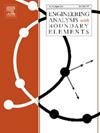Fourth-order phase field modelling of brittle fracture with strong form meshless method
IF 4.2
2区 工程技术
Q1 ENGINEERING, MULTIDISCIPLINARY
Engineering Analysis with Boundary Elements
Pub Date : 2024-11-06
DOI:10.1016/j.enganabound.2024.106025
引用次数: 0
Abstract
This study aims to find a solution for crack propagation in 2D brittle elastic material using the local radial basis function collocation method. The staggered solution of the fourth-order phase field and mechanical model is structured with polyharmonic spline shape functions augmented with polynomials. Two benchmark tests are carried out to assess the performance of the method. First, a non-cracked square plate problem is solved under tensile loading to validate the implementation by comparing the numerical and analytical solutions. The analysis shows that the iterative process converges even with a large loading step, whereas the non-iterative process requires smaller steps for convergence to the analytical solution. In the second case, a single-edge cracked square plate subjected to tensile loading is solved, and the results show a good agreement with the reference solution. The effects of the incremental loading, length scale parameter, and mesh convergence for regular and scattered nodes are demonstrated. This study presents a pioneering attempt to solve the phase field crack propagation using a strong-form meshless method. The results underline the essential role of the represented method for an accurate and efficient solution to crack propagation. It also provides valuable insights for future research towards more sophisticated material models.
用强形式无网格法建立脆性断裂的四阶相场模型
本研究旨在利用局部径向基函数搭配法找到二维脆性弹性材料中裂纹传播的解决方案。四阶相场和力学模型的交错解采用多谐波样条形状函数结构,并用多项式增强。为评估该方法的性能,进行了两项基准测试。首先,在拉伸载荷下求解了一个无裂纹方形板问题,通过比较数值解和分析解来验证方法的实施。分析表明,即使加载步长较大,迭代过程也能收敛,而非迭代过程需要较小的步长才能收敛到分析解。在第二种情况下,对承受拉伸载荷的单边开裂方形板进行了求解,结果显示与参考解十分吻合。演示了增量加载、长度尺度参数以及规则节点和分散节点的网格收敛的影响。本研究是使用强形式无网格法解决相场裂纹扩展问题的一次开创性尝试。研究结果强调了所代表的方法对于准确、高效地解决裂纹扩展问题的重要作用。它还为未来研究更复杂的材料模型提供了宝贵的见解。
本文章由计算机程序翻译,如有差异,请以英文原文为准。
求助全文
约1分钟内获得全文
求助全文
来源期刊

Engineering Analysis with Boundary Elements
工程技术-工程:综合
CiteScore
5.50
自引率
18.20%
发文量
368
审稿时长
56 days
期刊介绍:
This journal is specifically dedicated to the dissemination of the latest developments of new engineering analysis techniques using boundary elements and other mesh reduction methods.
Boundary element (BEM) and mesh reduction methods (MRM) are very active areas of research with the techniques being applied to solve increasingly complex problems. The journal stresses the importance of these applications as well as their computational aspects, reliability and robustness.
The main criteria for publication will be the originality of the work being reported, its potential usefulness and applications of the methods to new fields.
In addition to regular issues, the journal publishes a series of special issues dealing with specific areas of current research.
The journal has, for many years, provided a channel of communication between academics and industrial researchers working in mesh reduction methods
Fields Covered:
• Boundary Element Methods (BEM)
• Mesh Reduction Methods (MRM)
• Meshless Methods
• Integral Equations
• Applications of BEM/MRM in Engineering
• Numerical Methods related to BEM/MRM
• Computational Techniques
• Combination of Different Methods
• Advanced Formulations.
 求助内容:
求助内容: 应助结果提醒方式:
应助结果提醒方式:


